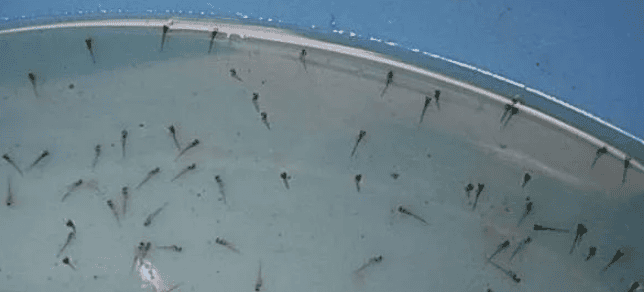(1) Hatching membrane
In the early stages of goldfish embryonic development, when the tail fin forms and gradually displays radial fin rays, the embryo begins to enter the hatching process. The newly hatched goldfish seedlings have a curved body with a large yolk sac, the mouth has been opened, and the entire body is transparent and visible, and its myotomes and circulatory organs can be clearly observed. At this stage, the gills only appear as a shallow groove, and the pelvic fins are not fully developed.
These newly born goldfish seedlings are not yet capable of swimming. They can only cling tightly to the fish nest or pool wall, or crawl on the bottom of the water. When frightened, they can only move from one location to another by jumping. At this time, the seedlings cannot take food directly from the outside world. They rely on nutrients in the yolk sac to maintain life. Therefore, there is no need to feed food at this stage, and management should pay special attention to avoid moving the hatching tank and aquatic plants at will to prevent the seedlings from falling to the bottom and being covered by impurities and causing death.

(2) 3~5 The queen takes off
As the nutrients in the yolk sac are completely absorbed, its size gradually decreases, and the fins of the goldfish seedlings are also increasingly developed. At this time, the fry no longer lie on their sides when swimming, but can swim horizontally and no longer rely on the adsorption of objects. Their lower jaws are already formed and can move flexibly. At this stage, the goldfish larvae have begun to forage, but because the fish are still small and slow in movement, they cannot quickly seize food and can only swallow large amounts of phytoplankton and native plants.
In order to meet the nutritional needs of these seedlings, egg yolk water is usually fed during this period. One egg yolk is enough to feed tens of thousands of fry. There are many ways to feed egg yolk water. One of them is to mix cooked egg yolk and water evenly, and then lightly sprinkle the egg yolk water around the aquatic plants or on the edge of the tank, so that the fry can feed easily. Another method is to wrap the cooked egg yolk with gauze, and then gently squeeze the gauze to allow the egg yolk water to slowly flow into the water.
It should be noted that when the belly of the fry turns light yellow, it means that they are full and should not be fed at this time. Just feed 1 to 2 times a day, and the amount each time should be controlled appropriately. Excessive egg yolk will affect the water quality. With such careful care, the goldfish seedlings will gradually grow stronger.

(3) After hatching, approx. 5~7 days
When the goldfish fry can swim freely to the surface of the water, it is the right time to start feeding "grey water" (protists). To ensure the safety of the fry, the "gray water" fed must be filtered through a fine mesh to prevent large daphnia from entering the fish pond, as these large creatures may harm the fragile fry. At the same time, in the process of feeding egg yolk water and gray water, we can put a large number of "red worms" (cladocerans) into the water. Red worms can not only serve as supplementary food for fry, but more importantly, they can clean up dirt in the water, help improve water quality, and provide a healthier living environment for fry.
(4) After one week of growth
When the goldfish fry reach about 1 cm in length, they begin to actively feed. At this time, they can feed various rotifers and red worms Or artificially hatched brine shrimp (be careful to avoid adding copepods). In addition, you can also add an appropriate amount of green water in the pool. This green water is rich in microorganisms and algae and can be used as auxiliary food for fry. These tiny organisms and algae in green water have a positive impact on the growth and discoloration process of juvenile fish, contributing to their healthy growth and color development.

 扫一扫微信交流
扫一扫微信交流
发布评论